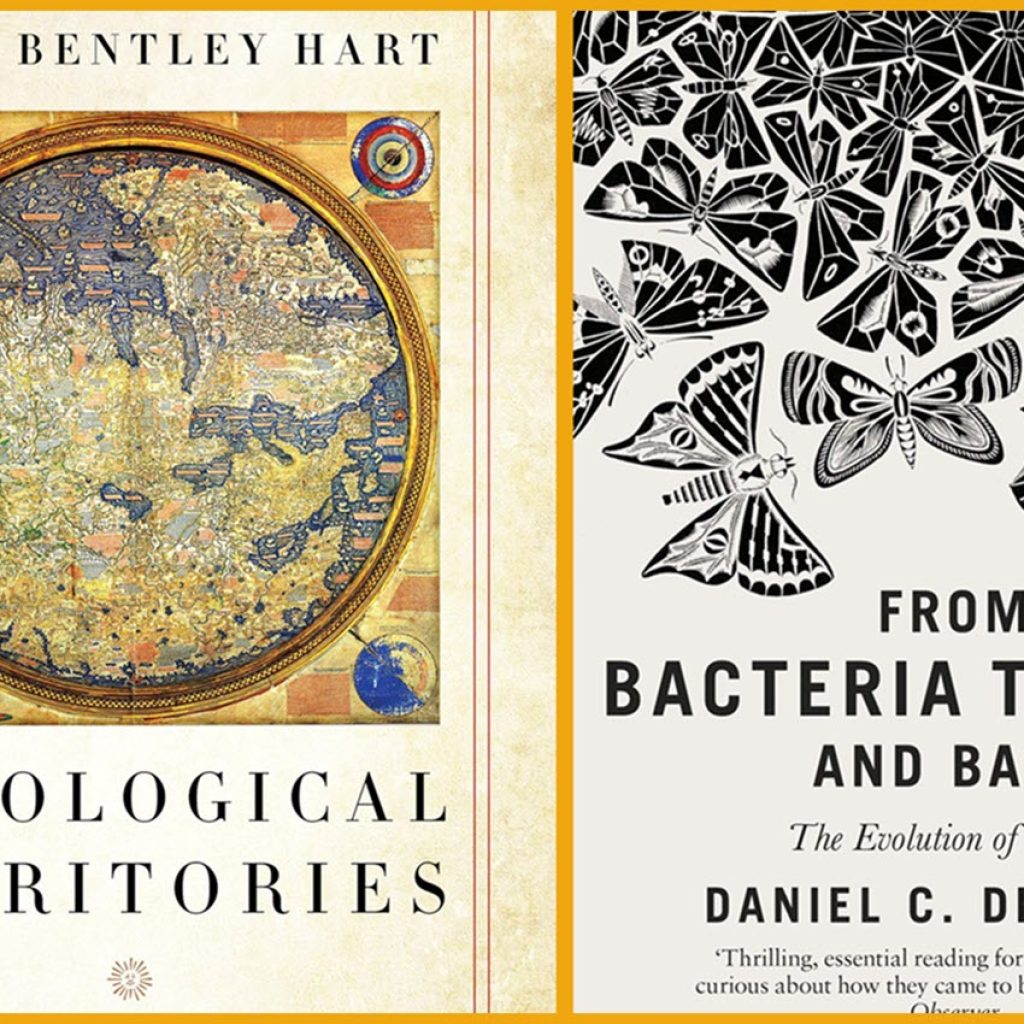In looking at the Flat Earth “thing/fallacy” vs Aquinas, Dante, Galileo, Scripture, and Science we can start with something from a brief look at inerrancy:
A — From the specific comment/link: https://disqus.com/home/discussion/standtoreason/morality_from_nature_audio/#comment-3379010783
B — It starts off with: “5 Quotes On Biblical Inerrancy… Quote #1….”
C — Quote #4 in that list is the following:
Begin Quote #4:
“Inerrancy (probably unjustly) has too much literalistic baggage associated with it that brings out ignorant objections like “the Bible says that the number PI is 3, and it is not exactly 3, therefore the Bible is not inerrant.” This baggage comes along with the claim “I believe the Bible”. Honestly Austin, if you are looking for the phrase that will satisfy irrational unbelievers so that they don’t associate idiotic views (that virtually no one holds) with Christianity, that phrase is “I give up, you are sooooo much smarter and more ‘scientificy’ than me!” I go ahead and embrace the phrase “inerrancy”.
Should someone try to say that number of digits of precision given for the size of Solomon’s cast sea is germane, I point to the doctrine of inerrancy as defined by the Chicago Statement which is easily available online. If they persist, they are attacking some view, but it’s not the doctrine of inerrancy. I also take the time to answer the objection. First, no number given will correctly equal the ratio of circumference to diameter. Would 3.1 satisfy the Bible-denier? Probably not.
What about 3.14? 3.142? 3.1416? 3.14159? 3.141593? Or this (a link to the first 100K digits after the decimal in PI) ? And if any of those do satisfy the Bible denier, why shouldn’t the approximation with one fewer significant digit serve as well? And if that, then why not 3, also a correct approximation of the ratio, serve? Or is it the contention of the Bible denier that in a description of a room, the God should have inspired the author to launch into a discussion of real numbers in order to avoid some dimwit construing an error at some later stage. Now, some, Bible-deniers may persist in saying that it should at least have said 3.14.
Why? Because atheism.
Well, even for these ‘thinkers’, it turns out that sea is described as having a flared rim. What would be the simplest way to measure the circumference of such a vessel? You would stretch a rope around the un-flared body and measure the rope. And what would be the simplest way to measure the diameter? Maximize the chord with the rope across the top of the sea (which would include the flared rim). Now measuring thus in the simplest way, the measurements come out to 10 cubits in diameter, or about 180 inches. And 30 cubits around, or about 540 inches. That’s assuming the typical 18 inches to the cubit. The flare of the rim is described as being one hand wide. That’s about 4 inches. When you maximize the chord, you’ll be measuring the width of the rim flare twice, so the inner diameter, given a measurement of 180 inches, is 172 inches. The ratio of 540 to 172 is about 3.14.”
End quote. (by WisdomLover)
Another item on the Flat Earth:
“This week, reading Aquinas & Dante w/students, talking literature & theology. Both texts happen to presuppose a spherical earth. Aquinas mentions it as something obviously knowable, and (the point of his illustration) demonstrable via two distinct sciences. In Dante, you can’t even start a rudimentary diagram of Inferno before noticing that it only works if you can theoretically go straight through the center of the sphere & come out on the antipodes. And once you add the planets & fixed stars, it’s even more obvious. Neither author is interested in teaching the sphericity of the earth; they presuppose it on their way to more interesting things. Students are often struck by this: How could authors who died in 1274 and 1321 know this fact, even taking it for granted? The answer, as it dawns on them, almost seems like a conspiracy theory: The idea that the medievals thought the earth was flat is a bit of propaganda devised by moderns who were counting on nobody reading any primary texts from the period. Sometimes students will try all sorts of explanations to avoid this conclusion: maybe only elites knew it; maybe they forgot it later on in the dark part of the dark ages; etc. But it makes more sense to ask if there’s any primary text evidence for the alleged flat belief.”
That is from Fred Sanders and the following was given in reply by Joe Rigney:
“[CS Lewis] loved to do this to people. Numerous essays where he quotes Ptolemy about the minuscule size of the earth relative to the cosmos, and then puts in the mouth of his modern ill-educated interlocutor, “They knew that then?!?” And the implications come crashing down like waves.”
Segues With Science, Bad History, and the Flat Earth:
- Did Bible writers believe the Earth was flat? https://christiananswers.net/q-eden/edn-c015.html
- Who invented the idea of a flat Earth? https://christiananswers.net/q-aig/aig-c034.html
- Have You Bought Into The Copernican Myth https://www.thinkingchristian.net/posts/2016/01/have-you-bought-into-the-copernican-myth/
- Putting Nature On The Rack http://edwardfeser.blogspot.com/2016/03/putting-nature-on-rack.html
- Who Refused To Look Through Galileo’s Telescope? https://bedejournal.blogspot.com/2006/11/who-refused-to-look-through-galileos.html
- Galileo Goes to Jail and Other Myths about Science and Religion https://www.amazon.com/gp/aw/d/0674057414/ref=nodl_
- The Enduring Lesson of the Galileo Myth https://www.thegospelcoalition.org/article/galileo-myth/
- History For Atheists https://historyforatheists.com/ This is a blog by an Atheist seeking to help Atheism by stopping it from appealing to such bad/fallacious history “…because rationalists should not base their arguments on errors and distortions…”
The following is from the now closed blog newtheist.org and was written by Matt Bilyeu:
Begin Quote/Excerpt:
The Galileo Controversy
Atheistic scientists have long painted the picture of religion as a suppressor of science and truth. They describe history as illustrative of the great divide between science and faith. Martyrs for science pay the ultimate price for their commitment to rational inquiry while an unjust and close-minded religious establishment tolerates no dissent and suppresses any discovery that can be perceived as a challenge. Chief among these martyrs, they say, is Galileo Galilei (1564-1642).
Galileo was born in Pisa in Italy on 2/15/1564. He later studied medicine at the university of Pisa but left before completing his studies. His family was well connected, however, and they secured a professorship for him at the university in 1589. It was during this time that he used the experimental method to demonstrate that objects of different weights fall at the same time. This was important as it also demonstrated the superiority of the experimental method over “armchair philosophy”. Galileo is attributed with developing this mode of experimentation into what we now know as the scientific method. He later left to work at the University of Padua. In 1610 Galileo wrote Sidereal Messenger, which publicized the discoveries that he had made with his telescope and made him an international sensation. Later Galileo would move to Florence. It was here that he wrote Dialogue Concerning the Two Chief World Systems: The Ptolemaic and the Copernican in 1632, which led to his trial in 1633. He lost the trial, and was sentenced to house arrest for life, which lasted 9 years until his passing in 1642.
Galileo was chiefly influential for his defense of heliocentrism (the belief that the sun was at the center and everything orbited it). He also developed the scientific method, as previously discussed, while working on laws of motion. His took the Bible not to be a scientific work, famously saying that, “The intention of the Holy Spirit is to teach us how one goes to heaven, not how the heavens go.” He felt that references to the solar movements in scripture were mere phenomenological language, such as our description of a “sunset” or “sunrise”. Such descriptions were not to be taken literally as scientific descriptions of the heavenly bodies but merely to be the observation of the author, much like we observe the “sunset” although we know that the sun does not literally set behind the horizon each day.
Galileo’s ideas relied heavily on those who came before him. He didn’t actually prove heliocentrism, it was Kepler who did that, but Galileo only popularized it with his literary works aimed at non-experts. Although Galileo is credited with using an experimental method to demonstrate that objects of differing weights fall at the same speed, John Philoponus had already made the discovery in the sixth century and later Thomas Bradwardine would say that this was true in a vacuum. Galileo also relied on John Buridan’s concept of impetus in his attempts to explain projectile motion. Finally, as we have already suggested, Copernicus was the primary support for Galileo’s ideas about heliocentrism.
The two major opponents of Galileo were Cardinal Robert Bellarmine (1542-1621) and Maffeo Barberini (1568-1644) who became Pope Urban VIII. Bellarmine was originally a Jesuit Professor who was noted for his role in the Inquisition in general and for his handling of the case of Giordano Bruno in particular. Bellarmine was a religious fundamentalist who believed in a literal interpretation of scripture. He felt that science should be based on the Bible, and that if the Bible did not speak to a particular scientific question then that question was not answerable. He felt that the scriptures should be read literally until forced to do otherwise. You might say that he felt there should be a presumption of literalism when reading scripture. As a result of this attitude toward scripture, Bellarmine officially warned Galileo that he could not defend, hold, or teach the views of Copernicus (which Bellarmine deemed to be in conflict with scripture, and therefore false). Bellarmine later died before Galileo’s official trial.
Pope Urban VIII called for the trial of Galileo. Originally Urban was an admirer, and enjoyed another work of Galileo’s, the Assayer. Urban even seemed to protect Galileo when the Congregation of the Index tried to have his book censored. Pope Urban VIII believed that it was impossible for man to know how the heavens really worked, because God, using other means, could achieve whatever result man might see in the heavens. Urban also took a lax attitude toward Copernicanism, which he felt was not formally heretical and which could not be proven conclusively.
Galileo tried the pope’s patience a little too far, as it turns out. In the previously mentioned Dialogues, Galileo presented heliocentrism as a proven fact (rather than just a theory) in direct violation of the warning given to him by the Inquisition and in conflict with the views expressed to him by the pope himself. Furthermore he presented the Pope’s argument about our inability to know how the heavens worked in the mouth of a character named Simplicio, who was the book’s simpleton. It is unclear why Galileo would take such rash measures to attack the pope who admired him and who had previously protected him from the Congregation of the Index’s censorship. Predictably, Pope Urban VIII did not take Galileo’s attack well and called him to trial. Galileo may not be the martyr his present day disciples make him out to be, as his initial defense was to reject Copernicanism and say that he had disproven it in his book (although he fooled no one). Ultimately Galileo lost his trial and was sentenced to house arrest.
As we have seen, Galileo’s trial was more about politics than it was about science. Pope Urban VIII was satisfied to maintain a relaxed attitude toward Copernicus until Galileo personally attacked him. This case also shows that the conflict is not between the Bible and science, as Galileo affirmed the Bible. The chief difference between him and Bellarmine were their attitudes towards scripture. Bellarmine insisted upon a literal interpretation of scripture unless and until forced to interpret it otherwise while Galileo assumed that scripture was not intended to be instructive on how the heavens operate and could be presumed to be figurative when speaking on the topic. It seems that although Galileo was closer to interpreting scripture correctly, a small modification may be in order. Although it is true that scripture’s primary purpose has little to do with the natural sciences; it is not the case that scripture has nothing to say about it. Until recently, modern science believed in an eternal universe without any beginning. It seems as though Galileo’s interpretation would have taken Genesis 1:1 to be figurative, which would have been a mistake. When scripture does make a clear statement about the world, such as claiming the world had a beginning, we should take such statements seriously.
In any event, Galileo’s trial shows not that there is a conflict between science and faith but that there is often a conflict between people over their worldviews, which can be intensified through aggressive and insulting language. This is hardly surprising, and should not pose a serious challenge to one’s faith or force one to choose between their faith and their minds.
End Quote/Excerpt.
The following: Christianity And The History Of Science https://metachristianity.com/christianity-and-the-history-of-science
That helps the transition into the following:
Science takes place inside minds. Mapping epistemology, conceptual ceilings, and the collective consciousness finds us within [Unintelligibility] which is the Child of [The Gods Play & The People Pay]. That was replaced by [Scientific Realism] for specific and historical reasons. That is why the History of Science just is THAT history — of those Two Mindsets — which in turn just is the History of Theism/s. Every culture took steps and yet every culture would simultaneously pull back. It is there that we find the question, “….Science flourished in the Christianized mindset… but *why*….?” That is looked at in the specific comment at https://randalrauser.com/2018/02/biblical-god-ignorant-science/#comment-4138241674 which opens up with: “…Science flourished in the Christianized mindset… but why…?”
The dual history of science and conceptual mindsets helps bring to light the following:
The Myth Of Religious Neutrality ~ An Essay on the Hidden Role of Religious Belief in Theories || Revised Edition || by Roy A. Clouser https://www.amazon.com/Myth-Religious-Neutrality-Revised-Theories-ebook/dp/B01D4TAXXC
Chapter 25: The Founding Myth of Atheism: Galileo, Copernicus, and the Church — in the book “Is Atheism Dead?” by Eric Metaxas. The following are borrowed from that same book:
- Modern science [is] a legacy, I might even [say] a child, of Christianity. —C. F. von Weizsäcker
- “…In ‘The Soul of Science: Christian Faith and Natural Philosophy’ Nancy Pearcey and Charles Thaxton make the case particularly compellingly, explaining that it was the worldview of the Christian faith that uniquely enabled science to emerge and flourish…”
David Bentley Hart looks at “Science and Theology: Where the Consonance Really Lies” at https://metachristianity.com/science-and-theology-where-the-consonance-really-lies-by-david-bentley-hart
Lastly, there IS ONE batch of faithful believers who DO believe in a Flat Earth ~ in a manner of speaking ~ as per the following:
Atheism: The World Is Flat – The None, The Non-, The Non-Theist https://metachristianity.com/atheism-world-flat-none-non-non-theist/





